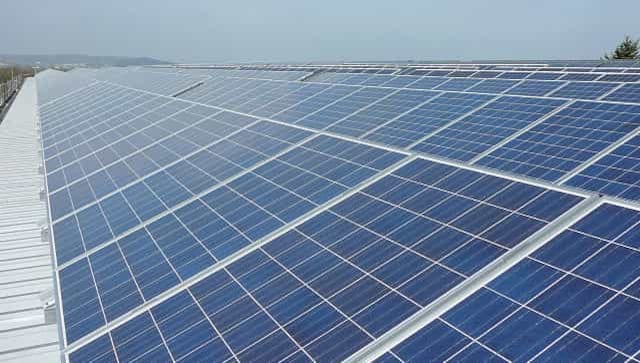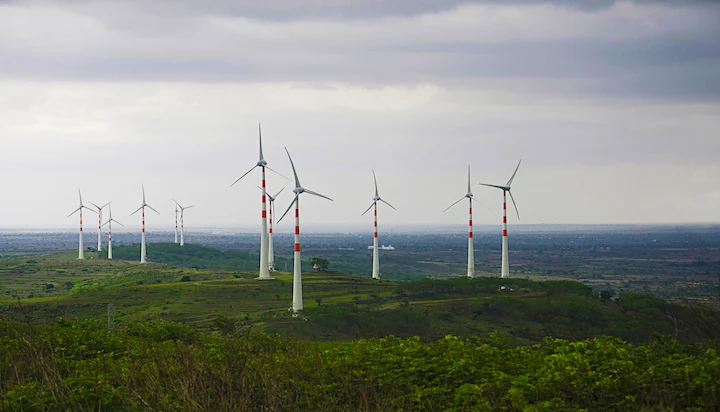As finance minister Nirmala Sitharaman read out her Budget speech in Parliament on 1 February, the stock prices of domestic solar manufacturers such as Adani Solar, Tata Power and Suzlon rose sharply in response to government’s big push to green energy.
With India setting specific goals for the reduction of carbon emissions as seen from the signalling at the COP-26 summit, the competition for dominating the global renewable energy markets is something to watch out for.
Incentives
With the Budget Session of the Parliament underway, it is important to note that the government is putting the renewable energy sector in the spotlight through the annual Budget and certain specific bills (to be tabled in this session).
The ‘Make in India’ initiative has effectively entrenched itself into the clean energy sector with the government providing production linked incentives (through the PLI scheme) of over $2 billion to improve the domestic manufacturing outputs of clean energy technology, especially solar.
The solar energy sector has been provided with a massive opportunity to increase its manufacturing capacity with specific grants kept aside to drive forward panels and electric vehicle (EV) batteries output. Solar, as an industry, remains the government’s biggest bet to reach the goal of 450GW installation capacity by 2030.
Along with the focus on solar energy, there is also the goal of upscaling the renewable energy infrastructure across the country. The government is looking at issuing green bonds to raise resources by the public sector to set up clean energy infrastructure projects. Data centres for grid-scale battery systems along with energy storage farms is on the radar.
The decrease in import tariffs on crucial electronic components needed for building these systems, as mentioned in the Budget speech, can also help improve India’s renewable energy infrastructure.
Other than the incentives laid out, there is also the Energy Conservation (Amendment) Bill, 2022 which is set to be tabled in this session of Parliament. The bill seeks to provide a regulatory framework and guidance for carbon trading and encourage the penetration of renewable energy sources into the energy mix.
Signal to China
China has grown to be the undisputed leader in the renewable energy market and the largest exporter of solar energy technology. With such a dominant position, China has effectively left most countries dependent on its exports for building a renewable ecosystem.
India has consistently relied on imports from China for solar hardware which is then used for the construction of panels and large-scale solar farms across the country. The Indian government has now increased the tax to 40 per cent on imports of solar modules and 25 per cent on imports of solar cells from the next fiscal year.
The intentions behind this include the reduction in dependency on Chinese solar hardware as well as spurring domestic manufacturing of the same. As one of the founding members of the International Solar Alliance (ISA), India is looking to concentrate the world’s solar industry in the subcontinent. The ISA has also started work on the world’s first transnational solar grid with India acting as the focal point for building the network. This future solar grid, spearheaded by India, is now being used to strategic signal the aim of dislodging China’s dominance in the global solar industry.
The focus on EV batteries manufacturing has also indicated India’s intention to leverage the EV market by attracting potential foreign investors (like Tesla). Similar to the solar industry, China dominates the EV market with considerable economic leverage as well as the establishment of norms and standards in the sector. India is now incentivising both domestic and foreign entities to set up EV battery manufacturing plants in the country.
This can lead to the dilution of Chinese influence as the world moves towards a clean energy market.
Moving away from India’s quest to reduce the influence of its neighbour in the renewable industry, the Indian government has also started focusing on border infrastructure. The development of distributed clean energy projects in border villages under the Vibrant Villages scheme is just one of the ideas to deter any Chinese incursions into Indian territory.
This, on the back of continued disengagement talks between the two countries. Green energy has now become the primary source being used to develop infrastructure capabilities in the border areas and as a potential deterrence mechanism.
What can we expect moving forward?
Both the Budget incentives, as well as the subtle signals aimed at China, will set the path for India’s growth in the international renewable energy market. The Indian government now views the solar energy sector as a potentially strategic sector for the future. This remains the rationale behind the reduction in dependency and advocating self-sufficiency in the field. As the world moves towards a clean energy dominated ecosystem, India is looking to position itself as one of the torchbearers of the renewable energy movement.
With the renewable energy market still up for grabs, India’s focus remains on the economic and geopolitical benefits that the market brings. For this, taking on China remains integral as they continue to dominate the sector. Hence, India is trying to come up with incentives for potential foreign investors and domestic manufacturers.
What remains to be seen is if India can take on the role of a credible alternative to China in the renewable energy space.
Source: firstpost.com









